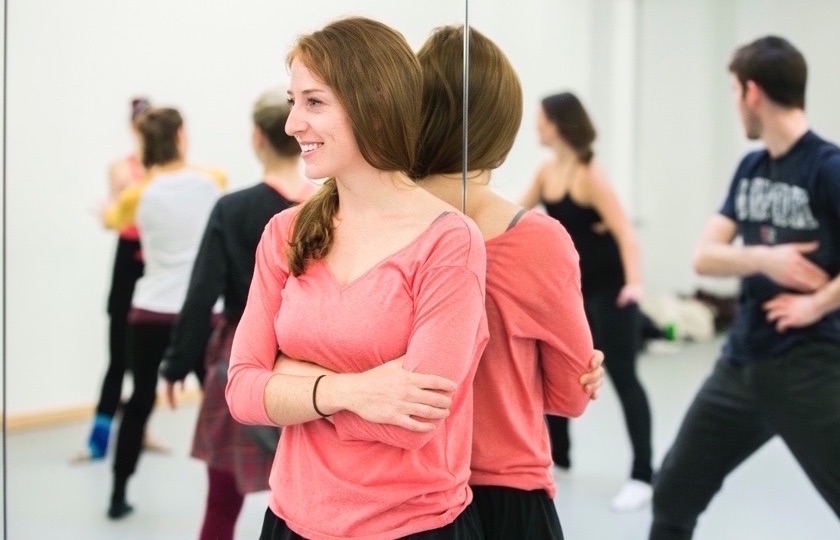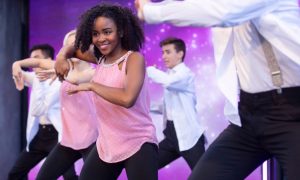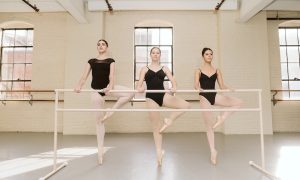Adult dancers attend an open class for a variety of reasons. Nearly all come because there is something about the atmosphere and physical work accomplished during dance class that cannot be replaced by other workouts. Alongside the desire to experience the sensation of moving as an artist comes the fear of measuring up to either the memory of what beautiful dancers we used to be and/or the dancers we aspire to be. Teaching adults, at any level of accomplishment, can be tricky business. Dance Informa checked in with a panel of professionals known for their fantastic adult open-division classes in order to share their insightful tips for making adult classes beneficial and fun.
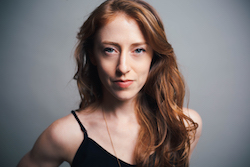
Emily Schoen. Photo by Mike Esperanza.
Help check the baggage.
Emily Schoen, artistic director of Schoen Movement Company and performer with Keigwin + Company
“My first priority in an adult class is to create a safe space. Using language like, ‘This is your time and your space to explore,’ or “You are safe here” can help fellow adults let down their walls and get more out of the class. We all have our insecurities, but they lead to more tension in movement and can stifle creativity. Plus, it’s simply more fun to dance when you feel free. I like to guide adults to this happy, free zone as much as possible.”
Vincas Greene, teacher at Eastern Washington University and director of Vytal Movement Dance Company
“Remind dancers that they are caring for their own body and that sustained dancing requires constant self-evaluation. For many dancers in adult classes, the joy of dancing is the goal. Pushing too hard at the start and competing with the dancers who have been continuously training will only cut short the desired return and development of the student.
I like to talk to new students for a few minutes prior to class. First, I thank them for coming and honor them for taking the plunge to dance with me. I explain the class progression and give them a little of what to expect in class, letting them know there are several dancers in the class who are very familiar with my movement that they can keep an eye on for reference. I then let each student know that modifications are always allowed, as the student knows her/his own limitations best and that I will be observing the dancing while not making many corrections as I get to know her/his dancing.”
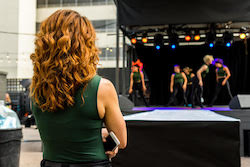
Hannah Brightwell observing a rehearsal from house. Photo by Mildred Villedas.
Hannah Bacon-Brightwell, teacher at Ballet Austin’s Butler Community Center for Dance and director of Revolve | a Movement Display
“I can’t tell you how many times I have had a new person come into my class and say to me, ‘I haven’t danced in (x) amount of years, so I’m going to be rusty.’ Or something along those lines! It’s kind of sad to me to think that someone feels they need to explain why they might be ‘bad’ at what we are trying to accomplish in the class, but at the same time I get it. We’ve all been there. So, to try to combat that, I’ve tried to establish an extremely open and positive environment in the first moments of my class. Whether I have them starting in Shavasana, standing with their eyes closed, or gathered together before we begin our warm-up, one of the first things I ask them to do is let go of their expectations, assess where they are that day and be accepting toward themselves. It also works to try to greet your new faces in the room one-on-one and give them some encouragement before beginning. But honestly, in working with adults (and being one myself), I find we need more reminders about how to treat ourselves in class than one may assume. So this theme is repeated throughout my class in a variety of ways.”
Set goals.
Schoen
“While goals are important, I like adults to not actually feel committed. We are all busy people outside of the studio, and if people come out of desire, it’s better than if they come out of obligation. I think goals for adults are simple: to be as present as possible throughout class and to give oneself as fully as possible in the ‘now’. When people accomplish this, they feel good, and attendance naturally reflects people’s experience.”
Greene
“Exercises can have varying degree of difficulty to meet the range of students in the class. As the student develops or re-develops dancing ability, the layers of difficulty can be added, giving the students a great sense of accomplishment. Degagé combinations can be given with a simple rhythm and medium speed for the dancers working at that level, while the same base combination can have added movements of the legs, arms and torso to challenge the students needing the complexity. I love to hear a student excitedly exclaim, ‘I added the arms and got the combination!'”
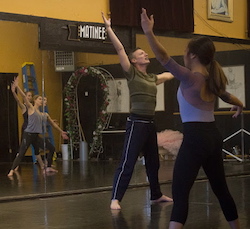
Vincas Greene in rehearsal with the Company Ballet School in Spokane, WA. Photo by Ira Gardner.
Bacon-Brightwell
“Keep in mind that everyone’s goals are different! If you can take the opportunity to get to understand what your students’ goals are, then you will be able to give them feedback and guidance that they can actually benefit from in your class.”
Warm up thoroughly.
Bacon-Brightwell
“There’s not one person entering your room who wouldn’t benefit from a challenging warm-up that is designed to build strength, flexibility and coordination, along with simple movement that is relative to what you will be working on in the class. On another note, be sure to offer modifications in things and communicate them clearly! Some people will push themselves to do something they shouldn’t because they don’t want to be embarrassed or they simply don’t know what else to do, so be aware and take care of the people following you!”
Schoen
“I am a huge advocate of thorough warm-up! Even though I’m a professional, I’m also a dancing adult, and I also need the thorough warm-up. Stretching and light conditioning not only feels good, but it enables you to dance more fully later in class without worrying about injury.”
Celebrate mature expression.
It is common for younger dancers, in the prime of their performance years, to become so focused upon the technical mastery of dance that they compromise performance quality. There is something liberating about not feeling like you have to have technical prowess in order to experience an impact through your dancing. Adult students enjoy moments of performance-based movement when they can ‘just’ move and let their artistic expression take the lead.
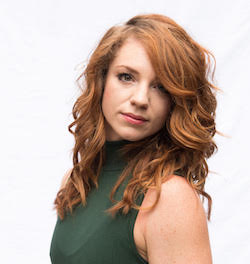
Hannah Bacon-Brightwell. Photo by Manuel Gonzales Jr..
Greene
“Be encouraging, and pick specifics. Make sure each dancer is aware that you ‘see’ and appreciate her/him during class. It may be a shout of encouragement in front of the class about a certain movement or combination done well or it may be a whispered ‘that spiral was beautiful’ as you pass the student. Tailor your comments to the student and keep the student moving in a positive direction with her/his dance.”
Bacon-Brightwell
“This is probably one of the most common themes in my class. In fact, most of the time, the meat of my class or combo will focus on getting the dancer to be more concerned on how the movement feels rather than how it looks.”
Keep it technical.
Adults like knowing we are getting the “real deal”. Create technically challenging combinations, teach the necessary skills, then encourage and provide necessary modifications. Most dancers will be bored by anything less.
Greene
“Keep and communicate high expectations for each student to be dancing at her/his own best. Sometimes you may need to tell them to ‘tone it down’ a bit to get the best results, but be ready to push them to new levels when the time is right. Adult dancers who return to your class have placed their trust in you and will respect your guidance. Give them your best, and they’ll return it over and over again.”
Bacon-Brightwell
“Do not neglect that teaching people how to understand your movement or message is a huge part of the class as well. Anyone can show steps…just like anyone can mimic steps, but to dig deeper and educate people about what and where your things are coming from is where the true magic lies!”
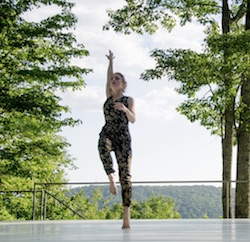
Emily Schoen at Jacob’s Pillow. Photo by Judith Stuart Boronson.
Provide detailed corrections.
Greene
“Get to know your students. Observe and talk to them. At this point in their training, adult students need very personal touches to help them keep achieving. Which students are shy, scared of moving larger, have specific injuries, love to throw themselves into anything, are bound by previous training, love to be used as an example… The adult dancer responds to the teacher’s personal care. When you make corrections from this state, the adult dancer understands that corrections are a statement of value and will listen to each detail.”
Bacon-Brightwell
“And don’t just throw it out there. Use your knowledge! If you see people struggling to get on their leg or not, talk about the things you know to help them make what they are doing better! Even the most advanced students in the room are there to grow and cannot see themselves the way that you can. Give them information about what you’re seeing so that they can get the most out of your class!”
Create community.
Dancers enjoy spending time and sharing life experiences with other dancers. Our experiences and outlooks are unique. Create opportunities for class members to visit and become acquainted. If allowed by the studio where you teach, consider creating a private social media or group page where students may interact.
Greene
“Creating an adult dance community is one of my personal goals for my region. I warmly welcome and then remind each class that we a doing something important for the art form every time we come together as dancers. At the end of every class, I encourage the dancers to spend time talking to each other and meet anyone new. My class regulars are in tune with this goal and share encouragement and welcome every class.”
Bacon-Brightwell
“Let your class be a place where students go to dance and enjoy the people around them! Encourage the camaraderie; be a part of it yourself; and your class will become a home for your students!”
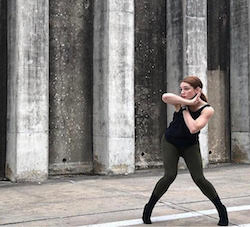
Hannah Bacon-Brightwell. Photo by Mildred Villedas.
Relax the rules…a little bit.
Dress codes and strict scheduling are generally not necessary for an adult class. There are exceptions, of course. If a student arrives a few minutes late to class, allow that person to join the class. Likewise, set a policy for very late arrivals. Injury prevention is the instructor’s primary concern.
Make your dress code preferences clear. Adults typically have injuries and body issues that need specific coverage to promote comfort, support and positive self-image. Do not compromise on the safety and instructional demands of attire, however, allow adults the freedom to choose what they wear to class.
Your class is your class.
Greene
“Occasionally, adult dancers come to class trying to re-create their own youthful experiences. That person may want you to take the place of and duplicate the style of a former teacher that was very important in that dancer’s life. Privately with the dancer, acknowledge that you are a different teacher with a different style. Explain your style and goals as a teacher, and then invite the dancer to become part of the community that is built around your class.”
Keep class fun.
Greene
“Your students are present for the joy and love of dance. Never be shy to communicate your joy and love for the art form and their dancing. Your positive energy provides an impetus for each of your students as a dancer, community member and person that is contagious.”
End on a positive note.
Bacon-Brightwell
“Give a recap on what you saw throughout the class and how they grew by the end; offer any guidance on events coming up in the city; and thank them for coming and invite them to return. Keeping yourself open for questions and/or feedback will make you more accessible and allow you to grow as well!”
By Emily Yewell Volin of Dance Informa.


